Hong Kong, the pearl of the Orient, a space immersed in stories...
Ni hao! from Hong Kong,
in quite unexpected circumstances, I was able to return to Asia twice in recent months.
It was a very nice coincidence, because I had left some space in my calendar to visit Hong Kong and Taiwan, but I never managed to make these trips happen. So much was happening…
But, as you can see, my travel luck made itself known. And so I was able to fulfill my dreams…
A September trip to China allowed me to have a 3-day trip to Hong Kong, which I gladly took advantage of. Bamboo Stories can now include this piece of Asia.
Hong Kong is a city of contrasts, where skyscrapers scratch the sky and traditional temples tempt with peace. Hong Kong is also a real paradise for gourmets, and Central and its surroundings offer countless possibilities for culinary adventures. Night markets and streets are full of life and smells, tempting with a variety of flavors.
In addition, the city holds many secrets and legends that have been passed down from generation to generation for centuries. Although it is difficult to clearly indicate a legend describing the creation of the entire city, there are myths and stories related to individual places and phenomena that have shaped what Hong Kong is today.
As you know, I travel in the footsteps of bamboo, wanting to discover the roots of this fascinating plant in this part of the world. And although bamboo was not as ubiquitous here as in other corners of Asia, the history and culture of this city turned out to be just as lush.
Three days in Hong Kong is definitely not enough to get to know all the nooks and crannies of this city. However, I managed to see the most important attractions and feel its unique atmosphere.
And that is what this story will be about.
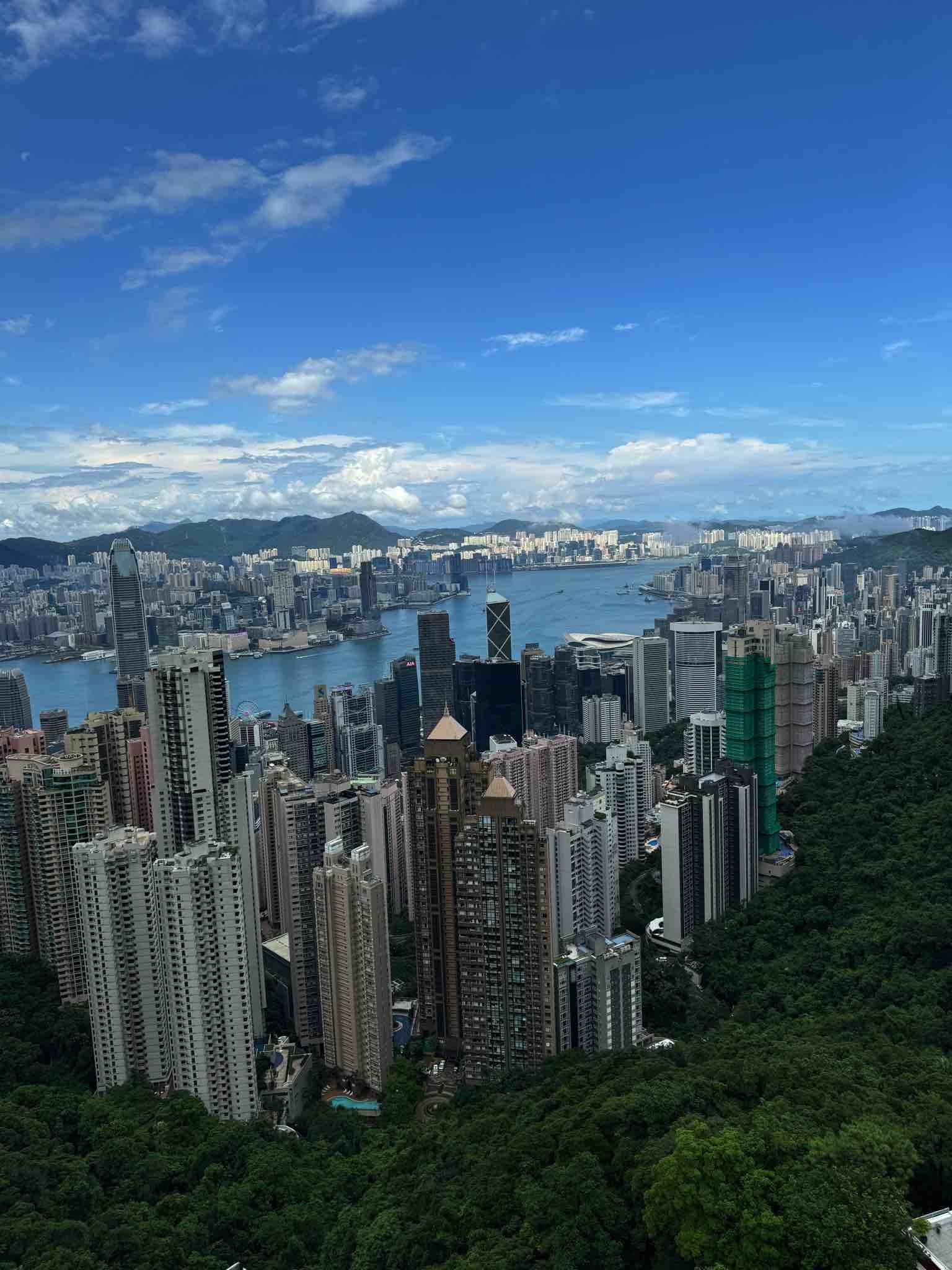
Let's start with logistics. How do we get here?
There are direct connections from Europe to Hong Kong (HKG), from most European capitals. The flight usually takes about 12-14 hours. You can also use connections with a transfer in other Asian hubs, such as Singapore or Bangkok, which can be another attraction in your travels. You do not need a visa to enter Hong Kong. The airport itself is very modern and clearly marked, so you will have no trouble moving from the arrival gate to passport control. It is similar at departure. The face scanning system and linking the scan to the passport greatly shortens the check-in time, which is mostly automatic. The check itself after arrival is pure pleasure. The officers are nice, smiling and after a few minutes we can go to the city.
If to the city, then definitely by public transport. In this respect, Hong Kong has a lot to offer. Like Shanghai, Singapore, Tokyo or Kuala Lumpur, the city is famous for its extremely efficient and extensive public transport system, which allows for quick and easy movement around the city. One of the key elements of this system is the Octopus city card.

Octopus Card - Your Key to Hong Kong
The Octopus card is a multi-functional electronic card that replaces cash on most public transport in Hong Kong, as well as in many shops, restaurants and vending machines.
Its advantages include:
- Convenience: You don't have to carry cash with you, just tap your card on the reader.
- Speed: Travelling is quick and hassle-free, saving you time.
- Versatility: In addition to public transport, the Octopus card can be used to pay in many places, which is very convenient for tourists.
- Promotions: There are often special offers and promotions for Octopus card holders.
How to buy and top up an Octopus card?
The Octopus card can be purchased from ticket machines in MTR stations, most bus stations, some shops and MTR customer service centres. The card is charged at the same locations. You can top it up with cash, credit or debit cards. You can buy the card at the airport and the easiest way to get to the city centre is the high-speed Airport Express, which reaches the heart of the city in less than half an hour. Great.
In the city itself, you will find various types of public transport:
- Metro (MTR): The fastest and most convenient way to get around the city. The metro network is very extensive and covers almost all important points in Hong Kong.
- Buses: The dense bus network allows you to reach places that the metro cannot reach. Buses run frequently and are well-marked.
- Trams: The historic trams are a popular tourist attraction, but also a convenient means of transport on Hong Kong Island. Double-decker, multi-colored and racing along narrow tracks, they make a colossal impression.
- Ferries: Ferries connect different parts of the city, which are islands. They are especially popular with tourists who want to admire the city's panorama from the water.
- Mid-Levels Escalator: The longest covered escalator in the world, connecting Central with SoHo.

There’s a lot to choose from, right?
Advantages of Hong Kong’s public transport system?
- Efficiency: The system is very efficient and punctual.
- Comfort: Trains, buses and trams are clean and air-conditioned.
- Safety: The system is safe and monitored.
- Ease of use: Even if you don’t speak Chinese, navigating the system is easy thanks to the English-language signage.
All in all, Hong Kong’s public transport system is one of the best in the world. The Octopus card makes getting around the city quick, convenient and enjoyable. If you’re planning a trip to Hong Kong, it’s definitely worth getting your hands on this card.

3 days in Hong Kong – a journey through time
Time flies, shall we go?
Even during my first walk through the bustling streets of Hong Kong, I felt as if I had traveled back in time. Among the modern skyscrapers, I came across ancient temples where residents made offerings to the gods. The Man Mo Temple in particular made a huge impression on me. Its interior, filled with incense and decorated with red lanterns, was like a portal to another world. Legend has it that the gods Man and Mo protect the city from all evil.
Another must-see on my map was Victoria Peak. The observation deck offers a breathtaking view of the entire city panorama. At night, when the city flashes with thousands of lights, the view is even more spectacular. It is said that in the fog that often envelops the hill, you can see the ghosts of the residents who once lived here.
Victoria Peak is not only a viewing point, but also a place with a rich history. Supposedly, the hilltop was once a fishing village and later a British fort. Today, you can find luxury hotels, restaurants and shops here.
I also couldn't miss the famous Victoria Harbour Boulevard. The view of the bay, the skyscrapers and a walk along the promenade is not only a convenient way to get around the city, but also an unforgettable experience. Ferries to the islands that make up the metropolis depart from here. During the cruise, you can admire both modern skyscrapers and traditional junks.
The Hong Kong History Museum allowed me to delve into the history of this fascinating city. I saw how Hong Kong developed from a small fishing village to one of the most important metropolises in the world. I also learned more about the culture and traditions of the inhabitants.

How to Visit Hong Kong with Only 3 Days?
First, you need to choose from the extensive list of attractions those that interest you the most.
Hong Kong is a place where tradition meets modernity, and the past coexists with the future. If you are looking for adventure and want to learn about the history and culture of Asia, Hong Kong is the perfect place for you.
But what to choose?
My suggestion for the list of attractions:
- Man Mo Temple
- Victoria Peak
- Central and Sightseeing Bus Ride
- Star Ferry
- Hong Kong Museum of History
- Kowloon Walled City Park (former walled city, now a park)
- Temple Street Night Market (night market with souvenirs and local food)
- Aberdeen Typhoon Shelter (boat shelter where you can try fresh seafood)
I started with a walk along Victoria Harbour. It is over 4 km of Wan Chai promenade with unforgettable views and several attractions such as the Observatory Wheel - a gondola with a wonderful view of the city, the Golden Bauhinia statue and numerous stalls.

It’s also the starting point for the city’s hop-on, hop-off sightseeing buses. It’s probably the best way to see Central, with its key buildings and shops, without the hassle of navigating miles of steep streets. You can always hop off and hop back on again for a quick tour.
Central, Hong Kong’s bustling business centre, is where tradition meets modernity. A bus ride through the district is a great way to see its diversity and see its top sights.

What will we see from the window/upper deck of the bus?
- Skyscrapers and banks: Central is a veritable jungle of glass skyscrapers, home to the largest corporations and banks. Here you can see the International Commerce Centre, one of the tallest buildings in Hong Kong, and the famous Bank of China Tower.
- Statue Square: This is the historic heart of Central. It is home to the Victoria Memorial and was once the site of public executions. Today, it is a popular meeting and party spot.
- SoHo: This trendy district is a paradise for food and nightlife lovers. Here you will find numerous restaurants serving international cuisine, trendy bars and boutiques.
- Hollywood Road: This street is famous for antiques and art. You can find both expensive works of art and cheap souvenirs here.
- Mid-Levels Escalator: The longest covered escalator in the world. It is a unique way to move around the hillsides and admire the city skyline.
- Tamar Park: A modern park that was built on the site of the former docks. It is a popular place for locals and tourists to relax.
- St. John's Cathedral: The most important Anglican cathedral in Hong Kong, built in the neo-Gothic style.
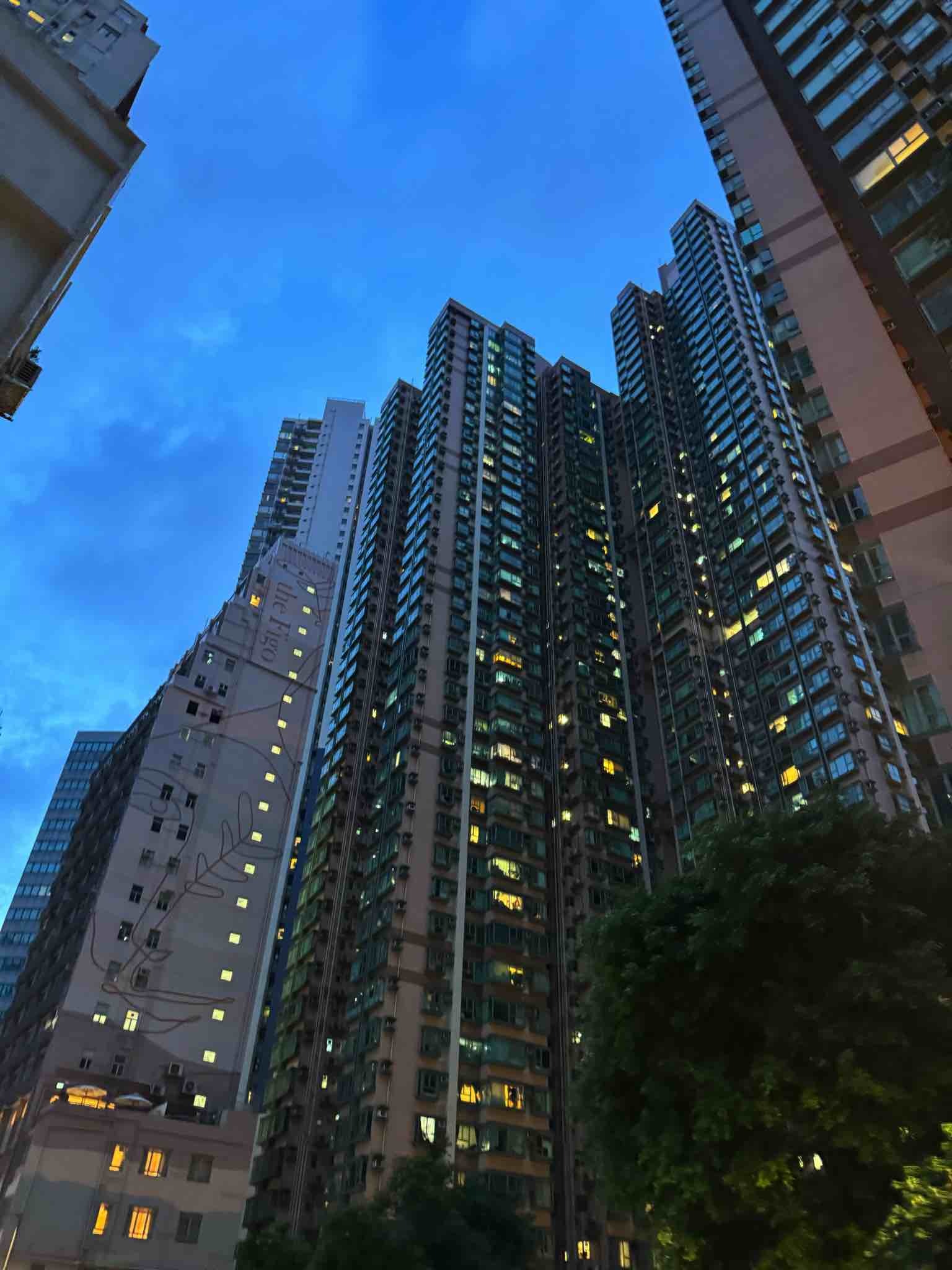
What is worth knowing before traveling by bus?
- Bus network: Buses run frequently, depart from the Ferry Terminal, and are relatively cheap.
- Maps and apps: Before you travel, it's a good idea to get a map or download an app with your route marked.
- Language: Although English is widely spoken in Hong Kong, it's worth knowing a few basic Cantonese phrases. The smile on local's face makes it worth the effort of pronouncing a few phrases.
- Tickets: Bus tickets can be purchased from the driver or at the check-in desk. The queue to board the bus can form up to half an hour before departure - well, the fight for a good seat is on from the start.
- Safety: Hong Kong is a very safe city, but it's worth being careful, especially in crowded places.

A bus ride through Central is not only a quick and convenient way to get around, but also a chance to learn about the history and culture of Hong Kong. From the bus window, you can see both modern skyscrapers and historic buildings, and you can also feel the pulse of this vibrant city.
And so the first day of my stay came to an end, tired but happy, I went to the hotel. And speaking of hotels, I have to warn you that the prices are high. Considering the location, good breakfast, size of the room and price, I definitely recommend the Best Western Causeway Bay Hotel. Close to the subway, close to Central and the promenade, and you should be able to stay under $300 for 3 nights. It won't get any cheaper...

Day Two: The Historic Peak Tram
A trip to Victoria Peak is a must-see for any visitor to Hong Kong. It’s a place that combines history, modernity and unforgettable views. And a ride on the historic Peak Tram adds even more charm to the adventure.
Victoria Peak, also known as The Peak, is undoubtedly the most iconic viewpoint in Hong Kong. Its summit offers breathtaking views of the entire city skyline, the harbour and the surrounding islands. It’s a place you have to visit to truly feel the pulse of this dynamic city.

One of the most characteristic elements of the journey to the summit of Victoria Peak is undoubtedly the Peak Tram. This historic tram, overcoming the steep slopes, provides tourists with an unforgettable experience.
A few facts:
- History: The Peak Tram was launched in 1888 and has been a popular tourist attraction ever since. Initially, it was powered by human power, then replaced by hydraulic power. In 1928, the tram was electrified.
- Route: The tram travels along a very steep route, overcoming a difference in height of about 396 meters in a distance of just 1.4 kilometers. The journey takes about 7 minutes and is quite an experience.
- Views: During the tram journey, you can admire the changing panorama of the city. At first, we see modern skyscrapers, and the higher we rise, the more picturesque the views of the bay and the surrounding hills become.
- Modernization: Although the Peak Tram is a historic monument, it has been modernized and equipped with modern safety systems. However, its traditional appearance and atmosphere have remained unchanged.
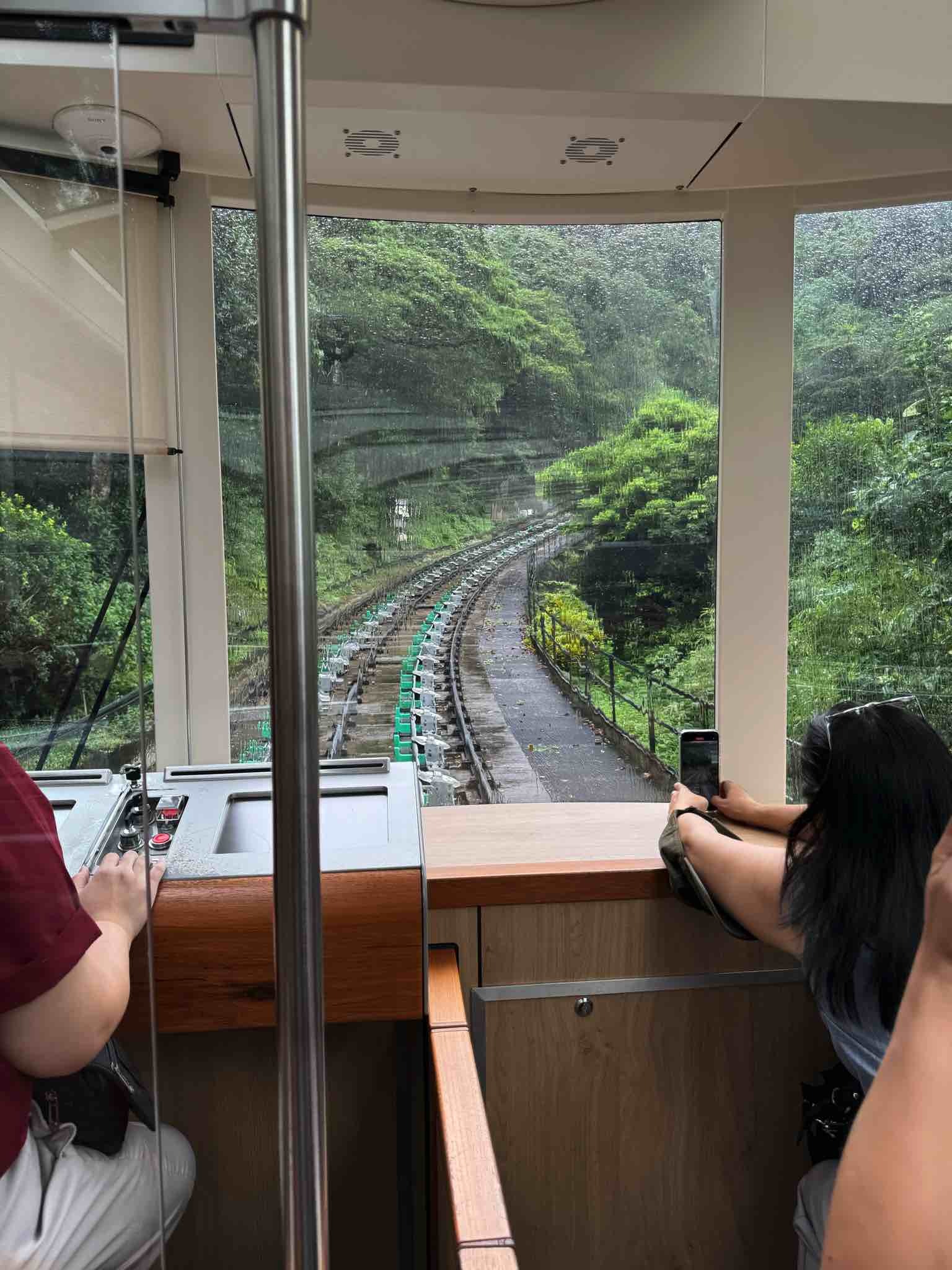
What can you see at the top of Victoria Peak?
Views!
After reaching the top, many attractions await us. We can walk through the beautifully landscaped park, admire the city panorama from various viewpoints, visit numerous restaurants and souvenir shops.
- Gardens: At the top there is a beautifully maintained garden, where you can relax and enjoy the peace.
- Wax Museum: For lovers of history and pop culture, an interesting place will be the wax museum, where you can see images of famous people.
- Sky Terrace 428: This is the highest viewpoint in Hong Kong, from which there is an even more spectacular view of the city.

Victoria Peak is a place shrouded in legends and mysteries.
I was told about the spirits of ancient warriors roaming the hills of this breathtaking viewpoint. The city panorama reminded me of the constant flow of time and history that has passed through here. The view of the densely built-up islands gave me the feeling of being immersed in another world, where history meets modernity.
Then I visited the Man Mo Temple, the oldest such place in Hong Kong, dedicated to the gods of literature (Man) and war (Mo). The aura of sanctity and mystery of this place almost made me believe in the legends about scraps of manuscripts, which in ancient times were supposed to give wisdom to those who asked the gods for advice. After all, myths and legends are part of Hong Kong's cult, which I will discuss in the final part of the story.
How to get to Victoria Peak?
In addition to the Peak Tram, you can also get to the peak by taxi or bus. However, the tram ride is definitely more atmospheric and leaves unforgettable memories.
Intereting Facts:
- The Peak Tram inspired many other cable railways around the world.
- The tram was damaged during World War II and did not resume operations until 1949.
- During peak season, queues for the Peak Tram can be very long.
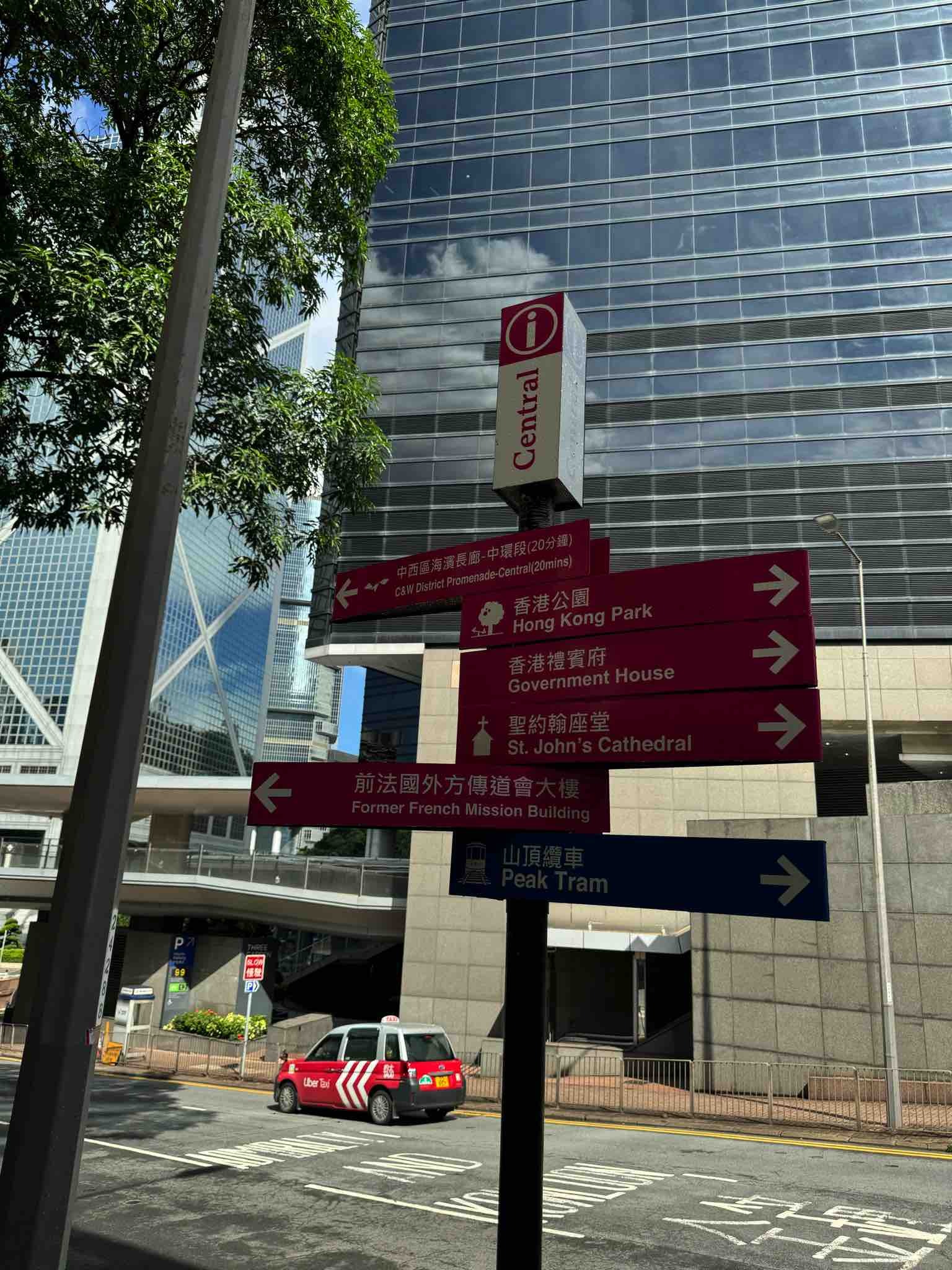
Day three - culinary adventures in the night markets and streets around Central
Hong Kong is a true foodie’s paradise, and Central and its surrounding areas offer endless opportunities for culinary adventures.
The night markets and streets are alive with life and aromas, tempting you with a variety of flavors. In the evening, I immersed myself in the loud hustle and bustle of Temple Street Night Market. Here, amidst the maze of stalls, oriental flavors and sounds, you could feel the spirit of ancient merchant streets. According to local myths, this is where the gods descend to earth once a year to walk among mortals and savor earthly pleasures.
What can you find at the night markets?
Hong Kong’s night markets are a feast for the senses.
You’ll find everything your heart desires here:
- Street food: Countless stalls offer a variety of street food, from simple snacks to more complex dishes. You must try:
- Wonton: Delicate dumplings stuffed with meat or vegetables, served in hot broth.
- Egg waffles: Ball-shaped puff waffles, served with various toppings, such as ice cream, fruit or chocolate.
- Fish balls: Fish balls on a stick, served with various sauces.
- Stinky tofu: Fermented tofu with a very intense smell, but incredibly tasty.
- Seafood: Fresh seafood, such as shrimp, octopus or mussels, prepared in many different ways.
- Soups: Hot and hearty soups, perfect for cold evenings.
- Desserts: A variety of sweets, such as puddings, cookies and fruit cocktails.

Culinary gems around Central?
In addition to the night markets, you will find many restaurants around Central offering cuisine from all over the world. You can enjoy authentic Chinese, Japanese, Thai, Indian and many more.
Foodie tips
- Try everything: Don't be afraid to experiment and try new flavors.
- Negotiate prices: Prices at night markets are often negotiable.
- Pay attention to hygiene: Choose stalls that look clean and have fresh produce.
- Drink plenty of water: Hot spices can irritate your throat, so it's a good idea to carry water with you.
- Seek out local specialties: Ask vendors about their favorite dishes.
The night markets and streets around Central are a real feast for the senses. Whether you're a fan of Asian cuisine or just want to try something new, you're sure to find something to your taste.
Fully fed and watered?
We can then transport ourselves into a world of esoteric stories closely related to the development of Hong Kong.
This is gonna be a little scary.

What legends are told from generation to generation in Hong Kong?
Hong Kong, a city of contrasts, holds many secrets and legends that have been passed down from generation to generation for centuries. Although it is difficult to pinpoint a single legend that describes the creation of the entire city, there are myths and stories related to individual places and phenomena that have shaped what Hong Kong is today.
Unfortunately, there is no single, dominant legend about the creation of all of Hong Kong. Instead, we have a collection of smaller stories that are often related to specific places or natural phenomena.
Here are some mystical legends:
- Lo Ting: One of the most popular legends tells the story of Lo Ting, the legendary ancestor of the people of Hong Kong. According to it, Lo Ting was the leader of an army that, after a lost battle, took refuge in the area of present-day Hong Kong. His descendants, mixing with the local population, were supposed to give rise to the inhabitants of this region. This legend is connected to the belief in the existence of half-human, half-fish creatures who were supposed to inhabit the area around Lantau Island.
- Temples and their histories: Each temple in Hong Kong has its own history and legend. They often tell of miraculous healings, the appearance of holy figures, or events that took place in a given place.
- Man and Mo as guardians: The most basic legend associated with the temple is the one that tells of the two gods to whom the temple is dedicated: Man, the god of literature, and Mo, the god of war. These gods are believed to be the guardians of the people of Hong Kong and provide them with happiness, prosperity, and protection from all evil. Students in particular often visit the temple to seek the gods’ blessings before exams.
- Incense and its power: The Man Mo Temple houses a huge amount of incense, which worshippers burn to make offerings to the gods. It is believed that the smoke rising from the incense has magical power and can reach the ears of the gods. The more incense that is lit, the greater the chance that prayers will be answered.
- Dragons guarding the temple: Legends say that the Man Mo Temple is guarded by dragons. These mythical creatures are a symbol of power and protection. It is believed that dragons watch over the temple and ward off evil spirits.
- Ghosts and the paranormal: Hong Kong, like many other cities with a long history, has its own legends of ghosts and paranormal phenomena.
The latter is worth recalling.
Hong Kong, with its long history and dense housing, is a place where ghost stories are an integral part of the culture. Here are some of the most famous and terrifying tales:
- The Bride of Kowloon Walled City: One of the most famous legends comes from the former crime-ridden city of Kowloon. It tells the story of a young bride who was forced to marry a dead man. Distraught, she committed suicide the night before her wedding. Her ghost, it is believed, still wanders the ruins of the city, searching for her beloved.
- The Fox Demon of Windsor House: This legend from the 1980s tells the story of a family who celebrated their child's first birthday at Windsor House. During the night, the mother had a dream about a red-eyed fox spirit threatening the child. Sure enough, the child died shortly after the event. Since then, many believe that fox spirits haunt the place.
- Headless men playing mahjong: Another terrifying story is of a flat on Leighton Road where the sound of a mahjong game could be heard in the middle of the night. When neighbours looked in, they saw five men playing cards, but they were all headless.
- Suicide on the Underground: In the 1980s, when Underground stations did not yet have automatic doors, there were stories of a girl in a white dress throwing herself in front of an oncoming train. It is said that her ghost still appears on the platforms, terrifying passengers.
Why are these legends so popular?
- Aura of mystery: Hong Kong, with its dense housing and narrow streets, creates a mysterious atmosphere that is easy to imagine the presence of ghosts.
- Notoriety of certain places: Places like the Kowloon Walled City, with its dark past, have become the perfect setting for ghost stories.
- The need to explain the unexplained: People have always sought explanations for phenomena they could not understand. Ghost legends have helped to make sense of strange events.
Should you believe these legends?
It depends on your imagination and what you want to believe. One thing is for sure – these stories stay in your memory for a long time and add even more mystery to Hong Kong.
Kowloon Walled City, with its fascinating but often dark history, has become a real mine for legends and ghost stories. This place, where the law did not fully apply, and life went on according to its own, often brutal rules, was the perfect ground for the birth of numerous legends.
In addition to the story of the Bride, which has already been described, there are other equally chilling stories associated with this place:
- Ghosts of the residents: Due to the huge population density and difficult living conditions in Kowloon Walled City, many people died young or in tragic circumstances. Their ghosts, it was believed, could not find peace and continued to wander the narrow streets and dark alleys of the city.Gangsters and Their Revenge: Kowloon Walled City was a place where numerous gangs ruled. There were often brutal clashes between them, which ended in death. The spirits of these murdered gangsters were said to haunt the places where they died, seeking revenge on their enemies.
- Children Lost in the Maze of Streets: Due to the complex layout of streets and alleys, it was easy to get lost in Kowloon Walled City. Many children disappeared without a trace, and their spirits were said to wander the city, crying for help.
- Ghosts of Experiment Victims: There were also stories of mysterious experiments that took place in Kowloon Walled City. Some of them were said to involve people who were subjected to cruel tortures. Their spirits, full of pain and suffering, were said to haunt the places where these experiments were conducted.
Why were these legends so popular?
- Atmosphere of fear: Kowloon Walled City was a place where an atmosphere of fear and uncertainty reigned. Ghost legends allowed people to explain the strange phenomena and sounds they heard at night.
- A need to escape from reality: Life in Kowloon Walled City was difficult and full of sacrifices. Ghost legends allowed people to escape from their daily problems and enter a world of fantasy.
- Passing on history: The legends were passed down from generation to generation, enriched with new details and elements. Over time, they became more and more terrifying and fascinating.
Today, although Kowloon Walled City no longer exists, the ghost legends still live on. The ruins of this place, which have been transformed into a park, still attract both tourists and Hong Kong residents who want to learn the dark secrets of this fascinating place.
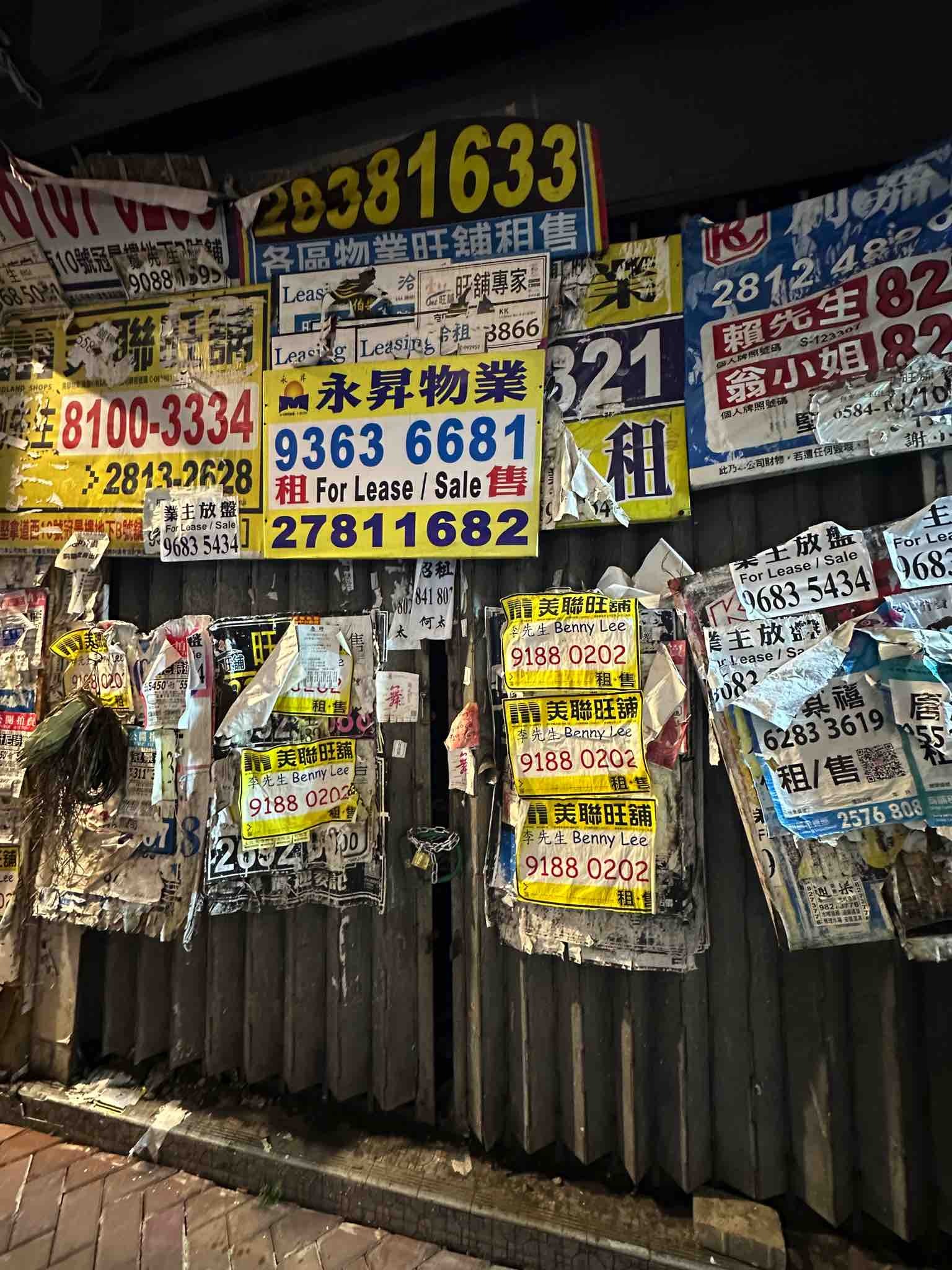
Traveling across Asia in search of traces of bamboo took me on an extraordinary journey full of history and mystery.
Hong Kong, the pearl of the Orient, was a special stop on this journey. My three-day tour of the city revealed to me the stories hidden in the urban structures, the legends of the past and the astonishing achievements of the present.
Hong Kong is a city that cannot be described in just a few words (hence the length of this story). It is a melting pot of cultures, where the past meets the present, and legends still slip through the modern structures.
Traveling around Hong Kong, I realized that this city is not just a place on a map, but also a space immersed in stories waiting to be discovered and relived.
"Tell me your past and I will tell you your future,"
said the most famous Chinese philosopher, Confucius, who lived 2,500 years ago.
More articles


Pages created with WebWave

























